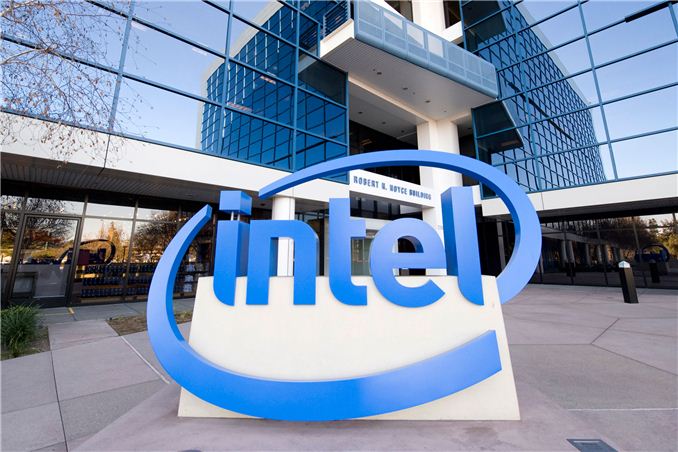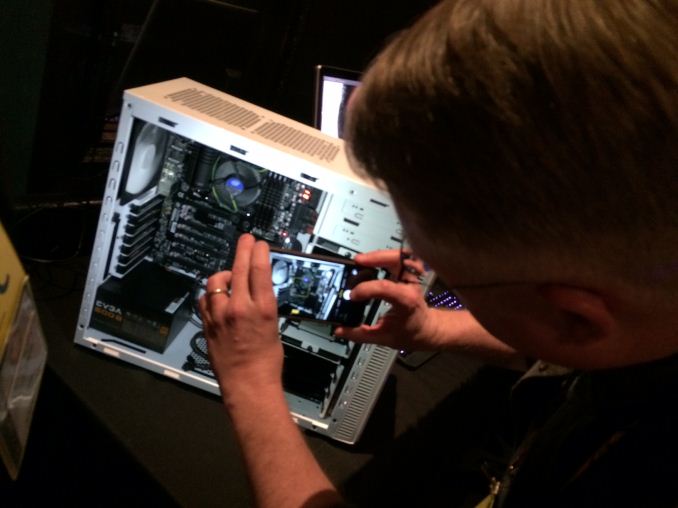Unlocked Socketed 65W Broadwell Iris Pro Desktop CPU Demoed by Intel at GDC15
by Ian Cutress on March 5, 2015 1:22 PM EST- Posted in
- CPUs
- Trade Shows
- Overclocking
- Broadwell
- Crystal Well
- Iris Pro
- Unlocked
- 65W
- 14nm
- GDC15

The next twelve months are set to be exciting times for the desktop space for Intel. While the current fifth generation mobile processors are coming to market, and the sixth generation being talked about in hushed tones, Intel demonstrated a PC that was listed as having a Broadwell desktop part (Broadwell-DT). The interesting culmination of factors surrounding this part is that it was listed as being socketed, unlocked and containing Iris Pro internal graphics.
The key elements here include the CPU being socketed (replaceable), unlocked (overclockable) and having Iris Pro, or Intel’s extended eDRAM segmentation usually under the Crystal Well name but with the much improved Generation 8 graphics architecture. While we have heard that an unlocked Iris Pro has been coming to desktop since March last year, very few details were given at the time, and the news today at least puts a TDP on such a part: 65W. Normally the high end SKUs from Intel are 77W to 85W, suggesting that this component may not in actual fact be an i7, or it could be an Iris Pro part but using one of the low power monikers such as ‘S’.
Image from Intel
The news also puts on a more firm date, so rather than ‘2015’ we get ‘mid-2015’, which puts it within the May to September timeframe. There are two important events occurring between those dates - Computex in June and the Intel Developer Forum in August, suggesting that Intel may aim for one of these events to have a formal launch.
Despite the launch of 14nm on the desktop, there has been recent talk of Intel’s next architecture, Skylake, also occurring within the year. This puts Intel in an interesting dynamic of releasing two different platforms for desktop within the same year. One could speculate and suggest that these will synergistically work in tandem, with Skylake-DT taking a segment and Broadwell-DT taking another segment. Where mobile fits into all this as well is difficult to tell, especially given the launch of Broadwell-U and Core-M within the past few months.
As much as we would like more information, it seems that the only thing we can tell is that the motherboard being used looks like an EVGA design due to the right angled power connector. Intel is also stating that the Iris Pro model will be great for all-in-ones (no argument there) which could also feature its RealSense camera, enhancing compute power and interactivity. It would be interesting if a socketed Iris Pro was truly aimed at the AIO market, but then such a SKU would not need to be unlocked. Unlocking for the purposes of overclocking is naturally aimed at the desktop market, although usually for gamers with discrete GPUs rather than Iris Pro.
Naturally we want to get our hands on a sample for review. Ryan is at GDC this week so if he gets a chance to spend a few minutes with the system it would be interesting to hear what they actually represented in the demo as well as more information about the system itself.











78 Comments
View All Comments
eanazag - Thursday, March 5, 2015 - link
Skylake DT could drag ass as long as Broadwell DT compared to the mobile launch and there would be no issues for Intel. In any case, I am happy to see Intel at least offering a serious iGPU in Desktop form factor without having to use the mobile part. AMD has very little room in the desktop market and iGPU heavy parts are the only place where buying AMD makes sense. Yet, that is still sacrificing CPU performance.The Start Swarm DX12 preview shows us that Intel's iGPUs are not at all held back by the CPU. I think Intel needs to up the performance considerably on the iGPU. They have come a long way since the 845 chipset GPU, which wasn't hard to do better than.
Iris Pro on the desktop better not be over $300 CPUs. If it is a $400+ part I will never touch it.
dragonsqrrl - Thursday, March 5, 2015 - link
"The Start Swarm DX12 preview shows us that Intel's iGPUs are not at all held back by the CPU. I think Intel needs to up the performance considerably on the iGPU."Yes but the performance limitation isn't what you would traditionally think of when you hear of a GPU performance bottleneck. It isn't a shader or ROP limitation, it's something to do with the front-end. If Intel could simply address this bottleneck, they could probably drastically improve their Iris Pro performance (at least in DX12 Star Swarm) even with the exist shader/rop config.
IntelUser2000 - Friday, March 6, 2015 - link
Broadwell did improve the front end geometry performance, but we don't know if that's the limitation.http://www.anandtech.com/show/8814/intel-releases-...
IMO this tells us Intel is not at all interested in pushing GPU, because they update it only when NEEDED rather than pursuing GPU advances like Nvidia and AMD.
patrickjp93 - Saturday, March 7, 2015 - link
You're totally incorrect. Intel is after GPU very, very heavily. But, they have to design around AMD's and Nvidia's near endless supply of patents. Intel's goal is server/supercomputer performance density with its iGPUs right now. The goal isn't gaming. That's just a bonus. When Skylake Xeons come with the top iGPU SKUs and confuse the hell out of enthusiasts, you'll have your answer. Intel's prepping for a fight to supplant CUDA and fight off HSA by using OpenMP (which can offload to Xeon Phi or to Intel iGPU).jeffry - Saturday, March 7, 2015 - link
CUDA cant be engaged with an iGPU. Such of a kind iGPU would take too much chip area away from the CPU itself.StevoLincolnite - Monday, March 9, 2015 - link
Not really.You would just have orders of magnitude slower performance due to the transistor constraints.
For instance, nVidia used to make integrated graphics as a separate chip compatible with Intel and ATI/AMD as well as VIA chipsets... And also made integrated graphics that was combined in the same die with it's own chipset solutions.
Conversely, one such chip was known as the "Geforce 8100" which funnily enough... Can handle CUDA.
It would be a hair pulling process however, it is slow.
jeffry - Friday, March 13, 2015 - link
Of course its possible. But painfully slow, which renders it useless in todays world. To do SIMD processing, a dedicated chip is needed (aka GPU).StevoLincolnite - Monday, March 9, 2015 - link
Intel have a cross licensing patent with AMD, not sure if that would include GPU patents, but I would assume so.Fact of the matter is.. Intel have never been able to design a fully competent GPU solution, today is a little better than what we had in the past, but the drivers for current Intel GPU's are still stupidly horrible.
Intel also uses less die space than AMD for it's GPU's too, so there is that.
patrickjp93 - Saturday, March 7, 2015 - link
That's only Anandtech's theory and not at all based in reality. There have been 7 driver updates since those tests were run. Let's see it done again, with high-end 2400MHz RAM this time.Flunk - Thursday, March 5, 2015 - link
Broadwell doesn't bring much of interest to the table for desktop users. This is probably Intel's answer to that, I'm still holding out until at least Sky Lake at this point unless Broadwell turns out to be a great overclocker (which seems unlikely).